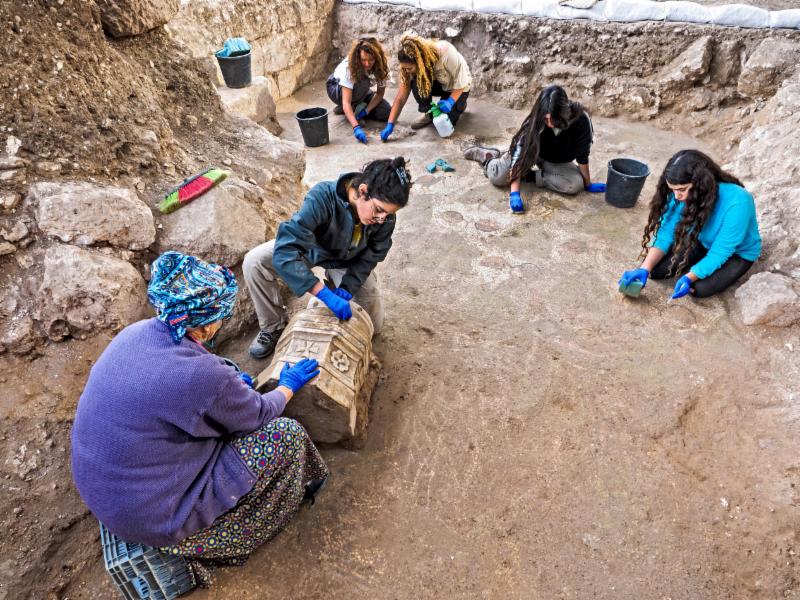The spectacular remains of a 1,500-year-old (Byzantine Period)
monastery and church decorated with mosaic floors and imported marble
elements are currently being uncovered during large scale excavations
conducted by the Israel Antiquities Authority in Beit Shemesh with the
help of over 1,000 teenagers. The excavation is being conducted prior to
the expansion of Ramat Beit Shemesh, funded by the Ministry of
Construction and Housing, and implemented by the CPM Corporation managed
by Anatoly Snider.

According to Benyamin Storchan, director of the excavations for the Israel Antiquities Authority, "We were surprised by the wonderful state of preservation of the ancient remains, and the richness of the finds being uncovered. The artifacts found in the large building, which seems to be a monastic compound, may indicate that the site was important and perhaps a center for ancient pilgrims in the Judean Shephelah region.

During the excavation, we uncovered before our eyes the remains of walls built of large worked stone masonry and a number of architectural elements including a marble pillar base decorated with crosses and marble window screens. The marble artifacts were brought from the region of Turkey and further inland by wagon. In one of the rooms we uncovered a beautiful mosaic floor decorated with birds, leafs, and pomegranates". "We already know of a number of ancient churches and monasteries in the Judean Shephelah" added Storchan, "but this one has outstanding preservation".

Until now, only a small percent of the monastery has been uncovered, which was abandoned in the 7th century CE for unknown reasons.

Since the beginning of the excavation during the summer, over 1,000 teenagers from different groups and organization, mostly schools and pre-military organizations have participated in the excavation.

According to Hadas Keich, 16 years old and student of the Sde Boker Field School "We searched for a way to fundraise for our class trip to Poland, and we decided to take part in the archaeological excavations. Little by little we uncovered here exciting finds, which helped to connect us to our country and its history. Amazing what is hidden here beneath our feet."

According to Benyamin Storchan, director of the excavations for the Israel Antiquities Authority, "We were surprised by the wonderful state of preservation of the ancient remains, and the richness of the finds being uncovered. The artifacts found in the large building, which seems to be a monastic compound, may indicate that the site was important and perhaps a center for ancient pilgrims in the Judean Shephelah region.

During the excavation, we uncovered before our eyes the remains of walls built of large worked stone masonry and a number of architectural elements including a marble pillar base decorated with crosses and marble window screens. The marble artifacts were brought from the region of Turkey and further inland by wagon. In one of the rooms we uncovered a beautiful mosaic floor decorated with birds, leafs, and pomegranates". "We already know of a number of ancient churches and monasteries in the Judean Shephelah" added Storchan, "but this one has outstanding preservation".

Until now, only a small percent of the monastery has been uncovered, which was abandoned in the 7th century CE for unknown reasons.

Since the beginning of the excavation during the summer, over 1,000 teenagers from different groups and organization, mostly schools and pre-military organizations have participated in the excavation.

According to Hadas Keich, 16 years old and student of the Sde Boker Field School "We searched for a way to fundraise for our class trip to Poland, and we decided to take part in the archaeological excavations. Little by little we uncovered here exciting finds, which helped to connect us to our country and its history. Amazing what is hidden here beneath our feet."
Photos & Video Credits: Assaf Peretz, Yaniv Berman,
Courtesy of the Israel Antiquities Authority

















